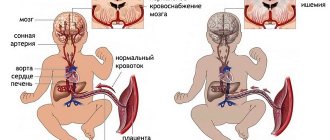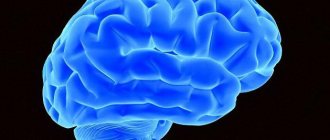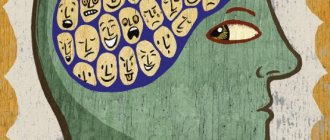Human immunodeficiency virus disease can occur in the form of hidden carrying of the virus, as well as in the form of acquired immunodeficiency syndrome, which is the extreme stage of HIV.
With the development of HIV and AIDS, almost all systems of the human body are affected and affected. The main pathological changes are concentrated in the nervous and immune systems. Damage to the nervous system caused by HIV is called neuroAIDS.
It is observed intravitally in approximately 70% of patients, and postmortem in 90-100%.
Causes and pathogenesis of the disease
The pathogenetic mechanisms of the effects of HIV on the nervous system have not yet been fully studied.
It is believed that neuroAIDS occurs due to direct and indirect effects on the nervous system. There is also an opinion that the reason lies in impaired regulation of the response process from the immune system. The direct effect on the nervous system is carried out through penetration into cells that carry the CD4 antigen, namely neuroglia of the brain tissue, cells of the lymphocyte membrane.
At the same time, the virus can penetrate the blood-brain barrier (the physiological barrier between the circulatory system and the central nervous system). The reason for this is that viral infection increases the permeability of this barrier, and that its cells also have CD4 receptors.
It is believed that the virus can penetrate brain cells through cells that can capture and digest bacteria that easily pass the blood-brain barrier. As a result of this, only neuroglia are affected, while neurons, due to the fact that they do not have CD4 receptors, are not damaged.
However, due to the fact that there is a connection between glial cells and neurons (the former serve the latter), the function of neurons is also impaired.
As for the indirect influence of HIV, it occurs in various ways:
- as a result of a rapid decrease in immune defense, infections and tumors develop;
- the presence in the body of autoimmune processes that are related to the production of antibodies to nerve cells that have built-in HIV antigens;
- neurotoxic effects of chemicals produced by HIV;
- as a result of damage to the endothelium of cerebral vessels by cytokines, which leads to disturbances in microcirculation, hypoxia, which causes the death of neurons.
At the moment, there is no clarity or consensus on the mechanisms of the origin and development of HIV and neuroAIDS; problems are caused even with the isolation of the virus in laboratory conditions. This has led to the emergence of a number of doctors and specialists who consider HIV an incorrect concept, but do not deny the very existence of HIV infection.
HIV dementia
All iLive content is reviewed by medical experts to ensure it is as accurate and factual as possible.
We have strict sourcing guidelines and only link to reputable sites, academic research institutions and, where possible, proven medical studies. Please note that the numbers in parentheses ([1], [2], etc.) are clickable links to such studies.
If you believe that any of our content is inaccurate, out of date, or otherwise questionable, please select it and press Ctrl + Enter.
HIV dementia is a chronic loss of cognitive abilities as a result of infection of the brain by HIV and opportunistic microorganisms.
HIV dementia (AIDS dementia complex) can appear in the later stages of HIV infection. Unlike other types of dementia, it mainly affects young people. Dementia may result from HIV infection or secondary infection with JC virus, which causes progressive multifocal leukoencephalopathy. Other opportunistic infections (including fungal, bacterial, viral, protozoan) also contribute.
In isolated HIV-associated dementia, pathomorphological changes develop in subcortical structures as a result of infiltration by macrophages or microglial cells of the gray matter of the deep parts of the brain (including the basal ganglia, thalamus) and white matter.
The severity (prevalence) of HIV dementia in the late stages of HIV infection ranges from 7 to 27%, but 30-40% of patients may have moderate cognitive impairment. The incidence of dementia is inversely proportional to the number of CD 4+ cells in the peripheral blood.
AIDS caused by HIV is characterized by damage to the central nervous system, which can also be attributed to slow infectious processes in the central nervous system. The pathogenesis of central nervous system damage in neuroAIDS is associated with the direct neurotoxic effect of the virus, as well as with the pathological effect of cytotoxic T cells and anti-brain antibodies. Pathomorphologically, atrophy of the brain substance is revealed with characteristic spongioform changes (spongiformity of the brain substance) and demyelination in various structures. Such changes are especially often noted in the semioval center, the white matter of the hemispheres, and less often in the gray matter and subcortical formations. Along with pronounced neuronal death, astroglial nodules are observed. Direct brain damage due to HIV infection is characterized by the development of subacute encephalitis with areas of demyelinization.
Clinically, the so-called HIV-associated cognitive-motor complex is noted, which includes three diseases:
- HIV-associated dementia:
- HIV-associated myelopathy:
- HIV-associated minimal cognitive-motor disorders.
Primary and secondary neuroAIDS
There are two groups of neurological manifestations that are associated with HIV infection: primary and secondary neuroAIDS.
In primary neuroAIDS, HIV directly affects the nervous system. There are several main manifestations of the primary form of the disease:
- aseptic meningitis;
- vacuolar myelopathy;
- vascular neuroAIDS;
- multiple mononeuropathy;
- facial nerve neuropathy;
- Guillain-Barre syndrome;
- acute meningoencephalitis;
- damage to the peripheral nervous system;
- sensory polyneuropathy;
- AIDS dementia;
- inflammatory demyelinating polyneuropathy.
Secondary neuroAIDS is caused by opportunistic infections and tumors that develop in an AIDS patient.
Secondary manifestations of the disease are expressed as follows:
- cerebral toxoplasmosis;
- cryptococcal meningitis;
- herpesvirus neuroinfection (herpesvirus encephalitis, myelitis, ganglioneuritis, cytomegalovirus encephalitis, polyradiculopathy);
- progressive multifocal leukoencephalopathy;
- lesions of the nervous system of a syphilitic nature;
- tuberculosis of the nervous system.
Most often, patients with neuroAIDS have the following tumors in the central nervous system:
- disseminated Kaposi's sarcoma;
- Burkitt's lymphoma;
- ganglioneuroblastoma;
- primary brain lymphoma;
- undifferentiated tumors.
Stroke due to HIV infection
Brain strokes are a disease of old age. Ischemia and hemorrhages in the brain are the cause of disability and death in those over fifty years of age. But there are situations in which a stroke occurs in a young person. A special case of such exceptions is people infected with the human immunodeficiency virus.
In 2010, the Journal of Acquired Immune Deficiency Syndromes published the results of five years of scientific work conducted by American doctors.
HIV-infected patients may have strokes at an earlier age than other people
It has been established that ischemic stroke in people with HIV in the age group of 18–29 years old occurs 4 times more often than in peers who are not carriers of the virus.
This work confirmed that adequate antiviral therapy and low levels of virus in the blood reduce the risk of cerebral ischemia in women and young patients.
Features of the clinical picture
Primary neuroAIDS often occurs without symptoms. In rare cases, neurological symptoms may appear 2-6 weeks after HIV infection. During this period, patients experience fever of unknown origin, swollen lymph nodes, and skin rashes. In this case the following appears:
- Aseptic meningitis . Occurs in a small number of patients with HIV (about 10%). The clinical picture is similar to serous meningitis. With aseptic meningitis, the level of CD8 lymphocytes in the cerebrospinal fluid increases. When viral meningitis has another cause, the number of CD4 lymphocytes increases. In rare and severe cases, it can lead to mental illness and disturbances of consciousness.
- Acute radiculoneuropathy . Caused by inflammatory selective damage to the myelin sheath of the roots of cranial and spinal nerves. This condition manifests itself in tetraparesis, sensitivity disorders of the polyneuric type, radicular syndrome, damage to the facial and optic nerves, and bulbar syndrome. Signs begin to appear and gradually become more intense both after a few days and after a few weeks. When the condition stabilizes for about 14-30 days, the intensity of symptoms begins to decrease. Only 15% of patients have sequelae after acute radiculoneuropathy.
Certain forms of neuroAIDS make themselves felt at the open stage of HIV infection:
- HIV encephalopathy (AIDS dementia). The most common manifestation of neuroAIDS. The presence of behavioral, motor, and cognitive disorders is noted. In approximately 5% of HIV patients, encephalopathy is the primary symptom indicating the presence of neuroAIDS.
- HIV myelopathy . It is expressed in dysfunction of the pelvic organs and lower spastic paraparesis. The peculiarity is the slow progression and differences in the severity of symptoms. About a quarter of people with HIV are diagnosed with this disease.
Complex treatment
Treatment of neuroAIDS and stopping its development are inseparable from the treatment of HIV infection, and form its basis. Patients are prescribed
antiretroviral therapy with medications that have the ability to pass through the blood-brain barrier and, as a result, block the development of HIV, stop the increase in immunodeficiency, reduce the intensity and severity of neuroAIDS symptoms, and reduce the likelihood of infections.
The most studied is the use of Stavudine, Zidovudine, Azidotimidine, Abacavir. Since the drugs are quite toxic, the prescription must occur with the consent of the patient, and according to an individual program.
It is also necessary to treat each specific form of neuroAIDS:
- HIV encephalopathy – Gliatilin, Cerakson, Thiocetam, Adaptol;
- stroke – Trental, anticoagulants;
- polyneuropathy – Citicoline, Malgamma, Clozapine;
- neuroinfections – etiotropic drugs;
- cryptococcal meningitis – Fluorocytosine, Amphotericin;
- toxoplasma encephalitis – Rovamycin, Azitrox, Clarothrimycin;
- herpes lesions - Cymevene, Abacavir, Acyclovir, Saquinavir.
The use of plasmapheresis and corticosteroid therapy is also effective. Treatment of tumors may require surgery, and consultation with a neurosurgeon is necessary.
In the situation of early detection of neuroAIDS (in the primary stages), and the presence of adequate treatment for the manifestations of the disease of a neurological nature, there is a possibility of slowing down the development of the disease. Often the cause of death in patients with neuroAIDS is stroke, opportunistic infections, or malignant tumors.
Source
Establishing diagnosis
NeuroAIDS occurs quite often, in most patients with HIV, so all carriers of the infection are recommended to undergo regular examination by a neurologist. HIV encephalopathy initially manifests itself in impaired cognitive functions, so in addition to studying the neurological status, it is also necessary to conduct a neuropsychological examination.
In addition to the basic studies that patients with HIV undergo, to diagnose neuroAIDS it is necessary to turn to tomographic, electrophysiological and liquorological research methods.
Patients can also be referred for consultation to a neurosurgeon, psychiatrist, and other specialists. The effectiveness of treatment of the nervous system is analyzed for the most part using electrophysical research methods (electromyography, electroneuromyography, evoked potential research).
Disturbances in the nervous system in neuroAIDS, as well as the study of their course and the results of therapy, are studied using computed tomography and magnetic resonance imaging.
An analysis of cerebrospinal fluid, which is collected using a lumbar puncture, is also often prescribed. If the patient, in addition to neurological manifestations, a decrease in the number of CD4 lymphocytes, has an increased protein level in the cerebrospinal fluid analysis, a decreased glucose concentration, and moderate lymphocytosis, then we are talking about the likelihood of developing neuroAIDS.
Why does stroke occur in HIV patients?
Neurocytes (cells that form the nervous system) are 100 times more likely to be affected by the virus than lymphocytes. In people infected with HIV, the nervous system is subject to viral attack in 80˗90% of cases, even if the blood and other organs and systems are not yet affected by the disease. In half of patients, signs of damage to the nervous system become the first manifestation of AIDS. The retrovirus infects cells that have a special type of receptor, CD4, on their surface. The virus produces toxins that damage healthy neurocytes and inhibit their growth.
AIDS virus
In addition to specific causes, there are also general ones that cause stroke:
- Blood pressure constantly exceeding 140/90 mm. Hg Art.
- Heart diseases: angina pectoris, arrhythmias.
- Hereditary predisposition.
- Diabetes.
- Drug and alcohol use.
- Obesity.
- Smoking.
- Decreased physical activity.
All of these factors “help” the formation of blood clots and the development of ischemic stroke.
Symptoms of HIV dementia
HIV dementia (including AIDS dementia complex - HIV encephalopathy or subacute encephalitis) is characterized by slowing of psychomotor processes, inattention, memory loss, complaints of forgetfulness, slowness, difficulty concentrating, and difficulty solving problems and reading. Apathy, decreased spontaneous activity, and social withdrawal are often noted. In some cases, the disease may manifest itself in atypical affective disorders, psychoses or seizures. A somatic examination reveals tremor, impaired rapid repeated movements and coordination, ataxia, muscle hypertonicity, generalized hyperreflexia, and impaired oculomotor functions. With subsequent progression of dementia, focal neurological symptoms, motor disorders - extrapyramidal, hyperkinesis, disturbances in statics, motor coordination and psychomotor skills in general - may occur. During the period of full-blown dementia, severe affective disorders, drive disorders, and regression of behavior in general are also possible. When the process is predominantly localized in the frontal cortex, a variant of dementia with Mori-like (foolish) behavior is formed.
AIDS dementia is characterized by cognitive, motor and behavioral disorders. Disorder of cognitive functions is represented by subcortical dementia syndrome with impaired short-term and long-term memory, slowed down thinking processes, and weakened concentration. Motor symptoms include changes in gait, poor postural stability, limb weakness, apraxia, and changes in handwriting. The most common behavioral disorders are emotional lability, a tendency to isolation, and apathy. In children, AIDS can cause underdevelopment of the brain, partial developmental delays, neurological symptoms, and cognitive impairment. This section discusses primarily AIDS dementia in adults.
Due to the lack of biological markers of the disease, the diagnosis of AIDS dementia is made by exclusion. In the cerebrospinal fluid, signs of activation of the immune system, pleocytosis, increased protein levels, and the HIV-1 virus are detected. Neuroimaging data are of auxiliary value in the diagnosis of AIDS dementia. According to European epidemiological studies, risk factors for AIDS dementia include advanced age, intravenous substance abuse, homosexuality or bisexuality in men, and a decrease in the level of CD4 lymphocytes. AIDS dementia develops at one stage or another in 15-20% of AIDS patients, and new cases are registered annually in 7% of people diagnosed with AIDS. According to some data, the survival rate of patients with AIDS dementia is lower than that of AIDS patients without dementia. The rate of progression and clinical manifestations of AIDS dementia are variable. Patients with AIDS dementia often develop comorbid psychiatric disorders, and these patients have increased sensitivity to the side effects of drugs commonly prescribed for these conditions.
Diagnosis of HIV dementia
Typically, the diagnosis of HIV dementia is similar to the diagnosis of other types of dementia, with the exception of finding out (searching for) the cause of the disease.
HIV-infected patients with untreated dementia have a poor prognosis (mean survival of 6 months) compared with those without dementia. During therapy, cognitive impairment stabilizes and some improvement in health may even be noted.
If the patient is diagnosed with HIV infection, or with an acute change in cognitive functions, a lumbar puncture, CT or MRI is necessary to detect infection of the central nervous system. MRI is more informative than CT, since it allows one to exclude other causes associated with central nervous system damage (including toxoplasmosis, progressive multifocal leukoencephalopathy, cerebral lymphoma). In the later stages of the disease, changes may be detected, which are represented by diffuse hyperintensity of the white matter, brain atrophy, and expansion of the ventricular system.
[6], [7], [8], [9]
Neuroimaging
Structural and functional neuroimaging methods can be useful in the diagnosis, determination of prognosis and choice of treatment for AIDS dementia. A correspondence was found between the severity of AIDS and atrophy of the basal ganglia, white matter lesions and diffuse atrophy on CT and MRI. However, there was no connection between neuroimaging and pathomorphological changes. PET, SPECT, magnetic resonance spectroscopy (MPQ) are more sensitive to changes in the basal ganglia and detect decreased cerebral blood flow and metabolic changes in infected patients without clinical manifestations of infection. MRS may in the future play an important role in predicting the response to certain drugs.
As with other forms of dementia, if AIDS dementia is suspected, it is important to rule out diseases that may worsen the condition, such as thyroid dysfunction, electrolyte disorders, blood changes, and other infections. It is necessary to analyze the medications taken by the patient, since some drugs prescribed to treat AIDS have an adverse effect on cognitive function. With AIDS, it is often not possible to remove “unnecessary” drugs, since the patient must take constant doses of antiviral drugs and protease inhibitors to prolong life. Patients with AIDS often have low levels of vitamin B12. Recognizing this complication is important, since vitamin administration can reduce the severity of the cognitive defect.
Source











